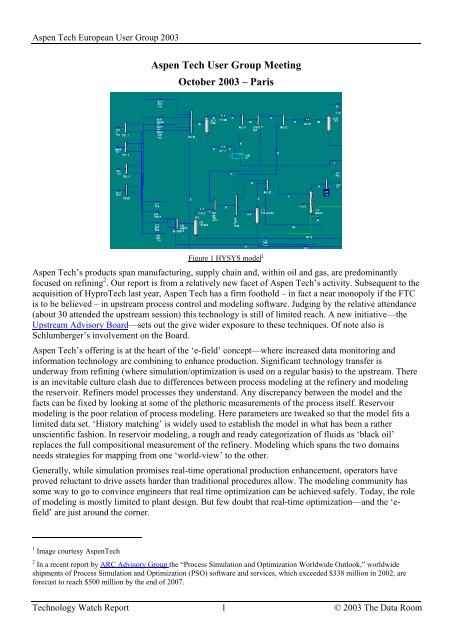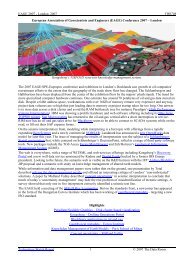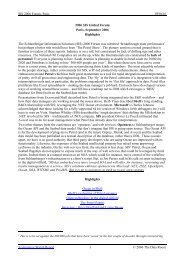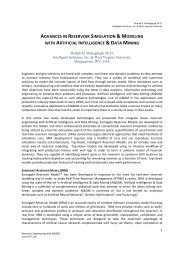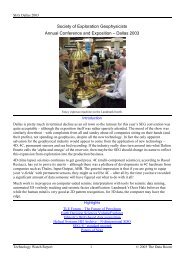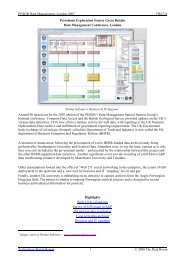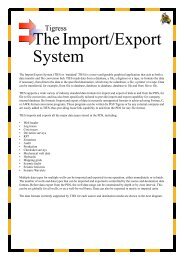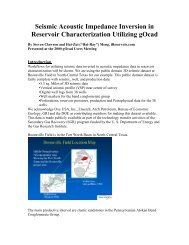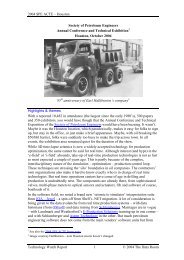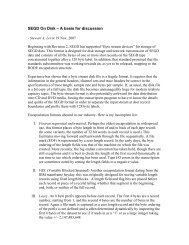AspenTech EU User Group 2003 - Oil Information Technology Journal
AspenTech EU User Group 2003 - Oil Information Technology Journal
AspenTech EU User Group 2003 - Oil Information Technology Journal
You also want an ePaper? Increase the reach of your titles
YUMPU automatically turns print PDFs into web optimized ePapers that Google loves.
Aspen Tech European <strong>User</strong> <strong>Group</strong> <strong>2003</strong><br />
Aspen Tech <strong>User</strong> <strong>Group</strong> Meeting<br />
October <strong>2003</strong> – Paris<br />
Figure 1 HYSYS model 1<br />
Aspen Tech’s products span manufacturing, supply chain and, within oil and gas, are predominantly<br />
focused on refining 2 . Our report is from a relatively new facet of Aspen Tech’s activity. Subsequent to the<br />
acquisition of HyproTech last year, Aspen Tech has a firm foothold – in fact a near monopoly if the FTC<br />
is to be believed – in upstream process control and modeling software. Judging by the relative attendance<br />
(about 30 attended the upstream session) this technology is still of limited reach. A new initiative—the<br />
Upstream Advisory Board—sets out the give wider exposure to these techniques. Of note also is<br />
Schlumberger’s involvement on the Board.<br />
Aspen Tech’s offering is at the heart of the ‘e-field’ concept—where increased data monitoring and<br />
information technology are combining to enhance production. Significant technology transfer is<br />
underway from refining (where simulation/optimization is used on a regular basis) to the upstream. There<br />
is an inevitable culture clash due to differences between process modeling at the refinery and modeling<br />
the reservoir. Refiners model processes they understand. Any discrepancy between the model and the<br />
facts can be fixed by looking at some of the plethoric measurements of the process itself. Reservoir<br />
modeling is the poor relation of process modeling. Here parameters are tweaked so that the model fits a<br />
limited data set. ‘History matching’ is widely used to establish the model in what has been a rather<br />
unscientific fashion. In reservoir modeling, a rough and ready categorization of fluids as ‘black oil’<br />
replaces the full compositional measurement of the refinery. Modeling which spans the two domains<br />
needs strategies for mapping from one ‘world-view’ to the other.<br />
Generally, while simulation promises real-time operational production enhancement, operators have<br />
proved reluctant to drive assets harder than traditional procedures allow. The modeling community has<br />
some way to go to convince engineers that real time optimization can be achieved safely. Today, the role<br />
of modeling is mostly limited to plant design. But few doubt that real-time optimization—and the ‘efield’<br />
are just around the corner.<br />
1 Image courtesy <strong>AspenTech</strong><br />
2 In a recent report by ARC Advisory <strong>Group</strong> the “Process Simulation and Optimization Worldwide Outlook,” worldwide<br />
shipments of Process Simulation and Optimization (PSO) software and services, which exceeded $338 million in 2002, are<br />
forecast to reach $500 million by the end of 2007.<br />
<strong>Technology</strong> Watch Report 1 © <strong>2003</strong> The Data Room
Aspen Tech European <strong>User</strong> <strong>Group</strong> <strong>2003</strong><br />
Highlights<br />
BP – production optimization<br />
ADMA – modeling the big picture<br />
Schlumberger - Reservoir and facility simulation<br />
Upstream Advisory Board<br />
Contents<br />
Plenary session..............................................................................................................................................................................2<br />
Production optimization with rigorous simulation models - Bryn Stenhouse, BP..................................................................3<br />
Case history – Pompano GOM asset.........................................................................................................................................3<br />
Case history Valhall optimization .............................................................................................................................................4<br />
Q&A ..........................................................................................................................................................................................4<br />
Marc Cochrane – ADMA – OPCO .............................................................................................................................................5<br />
Q&A ..........................................................................................................................................................................................6<br />
Dynamic Simulation in oil and gas modification projects - Truls Larsson, Aker Kvaerner .................................................6<br />
Dynamic Simulation of gas plant pressure control system - Claudio Mestichelli, ECOS group...........................................7<br />
The future of reservoir, well, production and facility simulation - Steve Miller, Schlumberger <strong>Information</strong> Solutions....7<br />
Q&A ..........................................................................................................................................................................................8<br />
HYSYS Upstream Option - Brian Wood, Product Manager....................................................................................................8<br />
The Integrated Asset Model – Andy Howell, <strong>Oil</strong> & Gas Director <strong>AspenTech</strong>......................................................................10<br />
Q&A ........................................................................................................................................................................................11<br />
Upstream <strong>Oil</strong> & Gas Advisory Board – Andy Howell, Brian Wood, Marcela Aguirre .......................................................11<br />
<strong>AspenTech</strong> Product Backgrounder...........................................................................................................................................11<br />
<strong>Technology</strong> Watch Service ........................................................................................................................................................12<br />
Plenary session<br />
Lee Riley welcomed the 400 plus attendees from 48 companies and 29 countries. 60% of attendees came<br />
from the engineering community – with the remainder from modeling and simulation.<br />
David Quillan provided an update on <strong>AspenTech</strong>’s financial position which is ‘becoming financially<br />
strong’ – with improved financial performance, a new $100 million line of financing and the company is<br />
now net cash positive 3 . Quillan commented that the last twenty years has seen significant investment in<br />
ERP systems. But the future will bring a move away from these transaction-oriented systems and will see<br />
integration of the two different worlds of finance and engineering via the enterprise portal. Aspen Tech<br />
3 Aspen Tech revenues for the first quarter 2004 (ending 30 th September <strong>2003</strong>) were $77.0 million, with software license<br />
revenues totaling $35.1 million, and services revenue totaling $41.9 million.<br />
<strong>Technology</strong> Watch Report 2 © <strong>2003</strong> The Data Room
Aspen Tech European <strong>User</strong> <strong>Group</strong> <strong>2003</strong><br />
itself is not in the portal business – but will be providing tools within the portal. Along with Aspen Tech’s<br />
engineering and manufacturing tools a new ‘operations cockpit’ will leverage technology from Accenture,<br />
Microsoft and Tibco and will offer a solution tailored to each vertical industry.<br />
Aspen Tech founder Larry Evans believes <strong>Information</strong> <strong>Technology</strong> projects offer a high return on<br />
investment for a low cost and risk. Evans stated that up to $500 billion ‘economic potential’ is lost<br />
through bad decisions which could be avoided by ‘operational excellence’. This is to be achived though<br />
modeling and IT-based decision support.<br />
Production optimization with rigorous simulation models - Bryn Stenhouse, BP<br />
Stenhouse is in BP’s E&P Tech (UTG) and provides central support in BP to study<br />
simulation/optimization (SimOpt) applied to a ‘plant’ i.e. a production facility. SimOpt technology comes<br />
from refining. Stenhouse is trying to persuade upstream operators to try/use SimOpt but there has been<br />
some skepticism, where daily ‘fire fighting’ is more of an issue.<br />
SimOpt – the big picture<br />
Surface facilities<br />
Separator - sales<br />
Production<br />
Injection<br />
Reservoir – pressure,<br />
material balance etc.<br />
The scheme is valid onshore, but more usually applied offshore where although the potential benefits are<br />
higher, access makes things difficult. Unsteady state operations are common, making the use of steady<br />
state models questionable. Limited data availability makes production SimOpt different to refining -<br />
where there are ‘at least two measures of everything’. Data reconciliation can be problematical. A<br />
learning for new plants has been to convince project designers to put meters in plant and use more<br />
sophisticated downhole instrumentation. This is a multi discipline activity – reservoir management, well<br />
performance, surface and commercial issues at play. These are especially complex in the gas business. A<br />
multi disciplinary tool is required for such modeling.<br />
Case history – Pompano GOM asset<br />
This 40K bpd mature asset is not equipped with fancy new technology – ‘you’ve got what you’ve got!’<br />
Platform and subsea tie-back cause wobbles with slugging. Pressure back off is mitigated across wells.<br />
An optimization study was performed with MDC (Emerson) using EPT’s modeling tool. The<br />
optimization problem revolves around which wells to flow to which pressure header and which to choke<br />
back. Other issues include oil/water/gas management, gas lift and compression. Note that the<br />
development is not a real time application – more intended for offline decision support. Scoping showed a<br />
<strong>Technology</strong> Watch Report 3 © <strong>2003</strong> The Data Room
Aspen Tech European <strong>User</strong> <strong>Group</strong> <strong>2003</strong><br />
clear opportunity to reduce gas lift to some wells to optimize production. This is a ‘classic’ coupled<br />
problem between facility and well–related variables.<br />
Pompano – division of labors<br />
EXCEL HYSYS GAP<br />
| | |<br />
Excel model built by MDC to control<br />
HYSYS and GAP opposite.<br />
GAP is embedded into HYSYS and<br />
shares variables.<br />
Case history Valhall optimization<br />
Topside<br />
Petroleum Experts tool for well<br />
performance optimization (GAP<br />
aggregates Prosper models which<br />
are ‘very popular’ in BP)<br />
Valhall is a mature North Sea asset producing 100kbpd from 38 wells. Two HP/LP compression trains<br />
with 7 stages of compression reflect incremental design creep and are perhaps the most complex facility<br />
ever! Process from remote tie-back again demonstrates slugging. The study was performed by MDC.<br />
Valhall benefited from a good infrastructure for online optimization with good bandwidth and metering.<br />
MDC could observe operations in real time. The complex constrained compression system was the target<br />
for optimization by making space for production in the compression system. A tax on produced CO2 was<br />
also an issue. The optimization boiled down to 6 numbers that operators need to track. Success factors<br />
included accurate asset models of wells and facilities based on tools of choice: Pipesim, HYSYS, Prosper<br />
GAP. A consistent data set for validation was also key. Optimizing linked black oil and compositional<br />
PVT models was a non trivial problem – models need to be ‘robust and available’ since optimization<br />
cannot halt operations. People and process proved more complex issues due to the cross-disciplinary<br />
nature and ownership of the project.<br />
In fact both of these projects have ‘struggled’ to provide value for BP because of people issues. Valhall<br />
optimization potential is significant–but operators have not taken much notice because the project did not<br />
have buy-in from day one. The reaction tended to be ‘very interesting–now let me get on with my job 4 .’<br />
The Valhall control room is moving onshore and it should be easier to manage optimization. Operators<br />
need training and there needs to be a clear offering – perhaps a performance contract including a 2%<br />
production hike. SimOpt needs to be delivered ‘at pace’, worldwide and for multiple assets. There is a<br />
need for ‘plug & play’ models integrating technology and commercial issues. Steady-state and dynamic in<br />
one model, Smarter optimization MINLP 5 , analytical derivatives and ‘models that answer questions that<br />
have not been asked yet’ are aims.<br />
Q&A<br />
Q – Is the reservoir modeling community involved?<br />
A – Yes, we talk to them although the timescale is different. It is an interesting dialog but we<br />
really need a new tool to optimize across different disciplines and time scales.<br />
4 Stenhouse also indicated that operators were concerned with potential gas blow-by as assets were driven closer to the edge.<br />
5 Mixed Integer Nonlinear Programming.<br />
<strong>Technology</strong> Watch Report 4 © <strong>2003</strong> The Data Room
Aspen Tech European <strong>User</strong> <strong>Group</strong> <strong>2003</strong><br />
Marc Cochrane – ADMA – OPCO<br />
Figure 2 ADMA-OPCO system architecture 6<br />
ADMA is operator of about half of the United Arab Emirates’ (UAE) production. Production goes to a<br />
central facility on Das Island. Environmentalism became an issue in the 90s and by year 2000 was<br />
serious. Flaring gas for production is now tightly regulated. In 1992, $100 million worth of gas was<br />
flared. In 2002 this was down to $6 million. Flare reduction studies used to be run on Excel. This has now<br />
been ported to Hyprotech and a year of production can be modeled in under an hour. Low pressure gas<br />
capture is critical at the DAS island facility. There is a lot of slugging in low velocity lines.<br />
Ahmed Hamdan presented the ADMA OPCO Production Planning Tool (PPT) including:<br />
• HYSYS – steady-state/dynamic model of process facility<br />
• ProFes – transient pipe model<br />
• Excel – integration and data I/O<br />
• Visual Basic – glue for all of above<br />
HYSYS – uses first principle thermodynamics<br />
• essential for system performance<br />
• integration to PPT interface – user doesn’t know it’s there<br />
• comprehensive models for Umm Sheist Das and Zakum<br />
• validated individual models @ < 2%<br />
6 Image courtesy ADMA-OPCO<br />
<strong>Technology</strong> Watch Report 5 © <strong>2003</strong> The Data Room
Aspen Tech European <strong>User</strong> <strong>Group</strong> <strong>2003</strong><br />
GUI – The Excel front end allows for selection of planning scenarios, data entry and result display. A tree<br />
view allows for selection of products, flaring, reports and ‘canned’ plots. Warning messages flag flaring,<br />
excess capacity, non-convergence etc.<br />
ProFes – pipeline transient simulation<br />
• 5 transient ProFes models to study behavior.<br />
Figure 3 HYSYS Model 7<br />
Figure 4 Profes pipe simulator 8<br />
Profes models allow the user to perform slug analysis, line pigging, and compositional tracking. The<br />
pipelines are integrated within the facilities models allowing the user to study different control problems,<br />
scenarios and troubleshooting. Success factors were the close interaction between the ADMA project<br />
team and <strong>AspenTech</strong>, flexible financing. The fact that the service provider is also the developer meant<br />
that the link between ProFes and HYSYS could be developed. ADMA and <strong>AspenTech</strong> have shared the<br />
value of this simulation optimization.<br />
Q&A<br />
Who uses it?<br />
A – Production planners. By the way this project has been a ‘glorious success’. It cost $500k and<br />
resulted in a 2% reduction in flaring, paying out in 6 months. It is also adaptable; new HYSYS<br />
models can be plugged in. The model is now being used for optimization.<br />
How accurate are the forecasts?<br />
A – For prediction, the absolute results are ‘shaky’ but the trends/direction indicated are good.<br />
This is work in progress. Currently only modeling topsides, next will be wells and then reservoirs.<br />
In 5 years we will be modeling the whole process.<br />
Dynamic Simulation in oil and gas modification projects - Truls Larsson, Aker Kvaerner<br />
Aker Kvaerner (AK) has 2,400 employees including 1,000 engineers and a 2.5 bn NOK turnover. AK is<br />
involved in all processes of field life and has used HYSYS for dynamic simulation for the last couple of<br />
years. Larsson’s thesis is that static modeling can produce overly conservative results and may indicate<br />
7 Image courtesy ADMA-OPCO<br />
8 Image courtesy ADMA-OPCO<br />
<strong>Technology</strong> Watch Report 6 © <strong>2003</strong> The Data Room
Aspen Tech European <strong>User</strong> <strong>Group</strong> <strong>2003</strong><br />
high risks of gas blow-by 9 choke collapse and poor valve operation. Only with a complete dynamic<br />
analysis can the true optimization potential be realized. Conventional station analysis based on API RP<br />
521 is satisfactory for a new build. But in a typical modification project the PSV (pressure release valve)<br />
is already sized. Here, dynamic analysis can be complex. But a peak pressure which is 10% lower that the<br />
static case may make the project feasible.<br />
Dynamic Simulation of gas plant pressure control system - Claudio Mestichelli, ECOS group.<br />
Ecos Engineering has some 60 process design engineers and billed 100k man-hours in <strong>2003</strong>. ECOS uses<br />
various HYSYS modules along with some in-house developed tools. This paper presents the dynamic<br />
simulation of and oil and gas plant pressure control system. The system includes the well head,<br />
production manifold, separator, CO2 removal ‘hold-up’ model and a high pressure elevated flare<br />
manifold. The project set out to select control philosophy – feed-back or feed forward – to analyze and<br />
predict plant behavior on upset conditions (e.g. shut down). All without stopping oil production. The<br />
main focus was the upset condition when the downstream gas station can’t receive gas (because of no<br />
demand) and issues relating to the CO2 removal unit shut down. A CO2 unit shut down simulation<br />
showed upstream pressure build-up; the control system cuts in. A time graph shows pressure rising and<br />
falling as wells shut down. Controller parameters can be tuned to keep production on-stream. The<br />
emergency shutdown system parameters can also be fine-tuned. But the study recommended that a valve<br />
on the CO2 unit should be changed to ‘quick opening’. This allowed for a CO2 unit shut down, gas flare<br />
kicking in and oil production keeps running with the plant remaining in spec.<br />
Q&A<br />
Did you consider putting a derivative action on controller?<br />
This will be studied later.<br />
Why can’t you save run parameters in HYSYS?<br />
This will be addressed. We are learning a lot from Aspen dynamics. There will be a new dynamic<br />
initialization option in HYSYS 3.2<br />
The future of reservoir, well, production and facility simulation - Steve Miller, Schlumberger<br />
<strong>Information</strong> Solutions<br />
Miller told of a plan ‘hatched in a West London pub’ to link Baker Jardine 10 and HyproTech’s 11 tools into<br />
a ‘total production system.’ The first issue was the problem of the silo mentalities. Reservoir simulations<br />
may be run with well and group controls but modelers don’t actually talk to facilities engineers. There is a<br />
tendency to optimize components, not the whole system. At the same time, everyone is ‘drowning’ in data<br />
of different formats and provenance. Data management for a small but well-instrumented field may<br />
involve 7000 data points/day. In other words, 27x10 6 points through life of field (every 15 minutes).<br />
PIPESIM models wells and connections. This links in to the reservoir engineering domain Open Eclipse.<br />
A new ‘Open Eclipse’ functionality allows Eclipse to be controlled by an external application. Field<br />
planning events can be built in to the model and displayed as time-based data. A graph showed coupled<br />
time steps across the reservoir model, compressor, pipe etc. PIPESIM can be driven from real time data<br />
from the field to run the model automatically and to establish new set points for operations.<br />
Electrical submerged pumps (ESP) are often used in modern production for gas lift and high water cut –<br />
but they increase downhole temperature leading to topside constraints such routing of hot wells through<br />
9 Gas flow in liquid line.<br />
10 Baker Jardine later became part of Schlumberger.<br />
11 HyproTech became part of <strong>AspenTech</strong>.<br />
<strong>Technology</strong> Watch Report 7 © <strong>2003</strong> The Data Room
Aspen Tech European <strong>User</strong> <strong>Group</strong> <strong>2003</strong><br />
different separator trains. Miller described early attempts to model these processes in Excel but warned<br />
that such developments may prove hard to maintain. Schlumberger’s solution was to take industry leading<br />
apps & provide connectivity. In 2001 a single branch link PIPESIM solver was embedded in HYSYS.<br />
The next step is full field modeling with a HYSYS/PIPESIM - Net interface which integrates a complete<br />
network of wells and flowlines to a HYSYS simulation. This provides full field-wide simulation,<br />
screening, product optimization etc. Variables such as choke size, gas lift, ESP power etc. can be set<br />
according to constraints of temperature, pressure, water handling capacity and compressor power.<br />
In the future, a new product, the Medusa Field Planning Center, Schlumberger will offer complete asset<br />
data management over a common data base. This will link Eclipse to field planning and optimization<br />
technology in Aspen’s AssetBuilder.<br />
Q&A<br />
Is the link to PipeSim dynamic?<br />
No it is steady state.<br />
Do you plan to model pipes in ProcessSim?<br />
PIPESIM model can be put anywhere in HYSYS model. PIPESIM is a general purpose network<br />
solver.<br />
Not all system components will necessarily come from Schlumberger. How open is the<br />
environment to third party applications?<br />
Schlumberger develops Open Systems; Medusa will tie to other vendor applications through the<br />
Open Eclipse development kit. PIPESIM has a documented Open API for third parties to write<br />
links. But Schlumberger wants to provide more direct integration with leading tools.<br />
To what extent are Schlumberger and Aspen competing in this space?<br />
More complementary than competitive. We are looking forward to sharing databases and to<br />
providing domain aspects to our tools – providing appropriate workflows for different users.<br />
HYSYS Upstream Option - Brian Wood, Product Manager<br />
Look to increase ROCE – daily/monthly summaries may contradict slow loop production. The problem<br />
(again) is one of of silos; petroleum engineering, production engineering and facilities. The new HYSYS<br />
Upstream Option targets these issues by integrating production engineering, facility engineering and<br />
hydraulics.<br />
HYSYS Upstream Option<br />
<strong>Technology</strong> Watch Report 8 © <strong>2003</strong> The Data Room
Aspen Tech European <strong>User</strong> <strong>Group</strong> <strong>2003</strong><br />
P<br />
e<br />
t<br />
r<br />
o<br />
l<br />
e<br />
u<br />
m<br />
Upstream Business Systems<br />
Asset Builder Executive<br />
Eng Apps Adaptors<br />
T<br />
e<br />
c<br />
h<br />
Upstream<br />
Thermo<br />
Upstream<br />
Hydraulics<br />
HYSYS<br />
Figure 5 HYSYS Upstream Option 12<br />
HYSYS Upstream V 3.02 was released October <strong>2003</strong>. A key difference between upstream reservoir<br />
simulation and process modeling is the concept of black oil. At the reservoir and during production, full<br />
compositional analysis of fluid is rarely available. Produced fluid is characterized as ‘black oil’ associated<br />
with a gas oil ratio and water cut. In process modeling, full compositional analysis of C1, C2, C3 etc can<br />
be made at any point in the process. To interface reservoir and process modeling, a concept of lumping<br />
and delumping is applied. Reservoirs with black oil only analyses and others with full compositional data<br />
can be studied together by lumping as the process is studied downstream and by de-lumping back<br />
upstream. Neotec’s Black <strong>Oil</strong> Methods and Infochem’s ‘multi-flash’ PVT analysis are embedded in<br />
HYSYS Upstream and provide cookbook methods for characterizing blends into ‘pseudo components’ for<br />
lumping. These techniques can also be used for production allocation techniques.<br />
Success story – Paragon Litwin & Burlington Reosources. Dhaharmakari – MLN field, Algeria. This<br />
project was presented at Aspen World 2002. 50% of the project effort was spent on validating<br />
compositional data. Now this is automated and production has increased by 500,000 bbl/year.<br />
Wood also showed HYSYS – PIPESIM-NET integrated simulation of a gas plant working with three gas<br />
suppliers. PIPESIM components can be dragged and dropped onto the model. Wells added with<br />
productivity index, completions, tubing and flowlines. These are grouped into the simulator 13 .<br />
12 Image courtesy <strong>AspenTech</strong>.<br />
13 All involving a large amount of tabular data entry.<br />
<strong>Technology</strong> Watch Report 9 © <strong>2003</strong> The Data Room
Aspen Tech European <strong>User</strong> <strong>Group</strong> <strong>2003</strong><br />
Figure 6 HYSYS PipeSim Net 14<br />
The Integrated Asset Model – Andy Howell, <strong>Oil</strong> & Gas Director <strong>AspenTech</strong>.<br />
The combination of Visual Basic and Excel is ‘a great tool for visualization’ but is not to be<br />
recommended for building mission critical applications. Work done for clients including NAM and and<br />
BP has led to the development of Asset Builder – which was ‘3 years in the making’. What began as a<br />
chemical engineering problem has become a data/IT issue. All companies have different views of their<br />
problems and data and of how integration will contribute to the Digital <strong>Oil</strong> Field realization– these must<br />
be managed before addressing optimization.<br />
AssetBuilder stakeholder operators work in a highly deregulated oil & gas business with many<br />
stakeholders – land owners, the pipeline company, gas plant, refinery etc. Everyone shares a bit of<br />
everyone’s contract. Upstream simulation is actually quite simple – but connecting the whole thing<br />
together across assets and operations is very complex. Maximum flow rate does not necessarily equate to<br />
maximum ROI. Third party well models can be deployed as well as MINLP Solvers LP Vector Update.<br />
One possibility was to roll all these components into one single application. But although this might be<br />
desirable, the silos want to use their own tools. So Aspen created Asset Builder (AB – a working title).<br />
This is described as 99% IT and 1% engineering – mostly Microsoft .NET and XML. Currently AB is<br />
steady state, the next version will be dynamic. AB uses publish and subscribe technology with XML and<br />
.NET. This has evolved from the OLE/DDE environment 15 into a tag data server supporting data drag and<br />
drop. A tree view displays currently available HYSYS cases to connect. Even real time videos of assets<br />
can be incorporated – ‘it’s important to provide the view of the asset as seen daily by client/user’.<br />
Because ‘you’ll never get away from Excel’ – so this has been embedded into HYSYS. AB has its own<br />
14 Image courtesy <strong>AspenTech</strong>.<br />
15 A Visual Basic ‘industry’ has evolved around HYSYS. This will have to go!<br />
<strong>Technology</strong> Watch Report 10 © <strong>2003</strong> The Data Room
Aspen Tech European <strong>User</strong> <strong>Group</strong> <strong>2003</strong><br />
Document Management System but works with Microsoft SharePoint Server or Documentum. Time<br />
stamped results show who did what and when in the integrated asset model. HYSYS now performs full<br />
compositional output and is no longer limited to black oil. MINPL genetic algorithms developed for<br />
polymer production are available for optimization of oil and gas production and contracts. Aspen’s MIMI<br />
supply chain integration technology has been used for gas lift optimization – which Howell described as<br />
the ‘low hanging fruit’ for product optimization.<br />
Q&A<br />
What of XML use in integration?<br />
Other XML (.NET) adaptors and database query technology from vendors such as TIBCO,<br />
Labrador and SSI can be used to plug AssetBuilder into production database applications like<br />
Schlumberger’s Finder.<br />
Is the main use in optimization or planning?<br />
AssetBuilder can be used to create an Integrated Asset Model for daily optimization and field<br />
development planning. Aspen has a whole suite of optimizers used in downstream . For Upstream<br />
we need to chose the best – so that the optimization can perform when wells go down and<br />
equipment is removed for maintenance. HYSYS also has the ability to plug neural network<br />
technology into AssetBuilder and perform gas-lift optimization with Schlumberger’s PIPESIM-<br />
NET running a parametric model in seconds – but if a sector of the gathering system goes down,<br />
neural networks can fail – so the neural network selector and event manager in AssetBuilder can<br />
be used to maintain robust optimization.<br />
Upstream <strong>Oil</strong> & Gas Advisory Board – Andy Howell, Brian Wood, Marcela Aguirre<br />
The Upstream oil & gas advisory board is a new Aspentech/Hyprotech venture. <strong>AspenTech</strong> is inviting<br />
Operators and EPC companies to ‘shape the way forward’ in collaboration with the ‘Schlumbergers of<br />
this world’. The next meeting is scheduled for Feb 4 th in Calgary. The plan is to associate Schlumberger<br />
and other third party vendors with <strong>Oil</strong> industry experts and shape the way the simulation and optimization<br />
market develops to support the Digital <strong>Oil</strong>field. A lot of Canadian companies are interested along with<br />
Shell, BP, ExxonMobil and ConocoPhillips. Saudi Aramco also is very interested.<br />
<strong>AspenTech</strong> Product Backgrounder 16<br />
• HYSYS Upstream uses industry proven methodologies to predict the behavior of the production fluid<br />
and integrate the reservoir characterization with the process facility simulation. Since accurate<br />
compositional analysis in the reservoir or at the wellhead is rare, leverage the two main industry<br />
methodologies used by petroleum and production engineers – Black <strong>Oil</strong> Thermodynamics and PVT<br />
Analysis – both provided by industry-leading technology companies in this area. Use a standard<br />
hydraulics data model for the integration of industry hydraulic applications into process simulations.<br />
Analyze hydraulic systems with a consistent topology definition of the network with any third party<br />
steady-state or transient flowline code. Integrate, within HYSYS, flowline simulators such as PIPESIM-<br />
NET from Schlumberger.<br />
• FLARENET. Design, rate and debottleneck single and multiple flare and vent systems. Calculate<br />
minimum sizes for new flare systems, or screen alternatives to relieve bottlenecks in existing networks.<br />
Identify dangerous relief scenarios during design phase while demonstrating regulatory compliance of<br />
plant flare and vent systems.<br />
16 From <strong>AspenTech</strong> product sheets.<br />
<strong>Technology</strong> Watch Report 11 © <strong>2003</strong> The Data Room
Aspen Tech European <strong>User</strong> <strong>Group</strong> <strong>2003</strong><br />
• ProFES 2P Tran / ProFES 3P Tran / ProFES Tranflo. Model steady state and dynamic behavior of<br />
multiphase flows in wells and pipelines. Account for two-phases, sand and slugs. Economically size<br />
pipelines, separators, slug catchers, and other equipment by modeling liquid and gas surges. Optimize<br />
startup, shutdown, and injection and depressurization rates. Predict behavior of complex three-phase oil,<br />
water, and gas flows. Provide solutions for systems with high water cuts, oil-water segregation problems,<br />
or vulnerability to corrosion.<br />
• HYSYS PIPESYS. Accurately model single and multiphase flows to design, debottleneck, and optimize<br />
pipeline systems. Account for pipeline elevation profiles, inline equipment, pipe composition and<br />
roughness, and fluid properties. Model networks with multiple flow paths. Perform forward and reverse<br />
pressure calculations. Compute detailed pressure and temperature profiles for onshore and offshore<br />
systems. Perform sensitivity calculations for system dependencies.<br />
• HYSYS OLGAS. Use industry-standard pipeline and well bore sizing correlations within HYSYS.<br />
Calculate pressure gradients, liquid holdups, and flow regimes.<br />
• Aspen AssetBuilder is an integrated asset model and supervisory system that lines up multiple HYSYS<br />
simulation cases and connects them to field decline curves, well network simulations and optimization<br />
and time stepping. Aspen AssetBuilder enables full integrated visual asset models to be used and<br />
maintained.<br />
<strong>Technology</strong> Watch Service<br />
This report was produced as part of The Data Room’s <strong>Technology</strong> Watch Reporting Service. For<br />
more information on this subscription-based service please visit the above link or contact<br />
Email info@oilit.com<br />
Tel +331 4623 9596<br />
Fax +331 4623 0652<br />
The Data Room<br />
7 Rue des Verrières<br />
92310 Sevres<br />
France<br />
<strong>Technology</strong> Watch Report 12 © <strong>2003</strong> The Data Room


